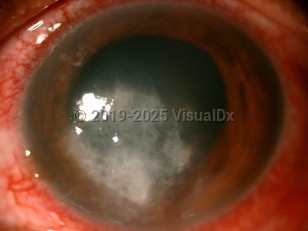Emergency: requires immediate attention
Pythiosis
Alerts and Notices
Important News & Links
Synopsis

Pythiosis is an emerging life-threatening infectious disease in humans and animals caused by the fungus-like organism Pythium insidiosum. This pathogen belongs to the kingdom Chromista, phylum Oomycota, and class Oomycetes. Pythium insidiosum had been the only oomycete human pathogen noted until ocular lagenidiosis mimicking Pythium keratitis was reported by Reinprayoon et al in 2013. The other species in genus Pythium are either saprophytes or plant parasites.
Cows, horses, and dogs are the most commonly infected animals. Animal pythiosis can present with development of cutaneous/subcutaneous granulomatous lesions as well as deep tissue invasion.
Human disease has been classified into 4 categories based on clinical presentations: cutaneous/subcutaneous, ocular, vascular, and disseminated. In a retrospective study by Krajaejun et al of 102 cases in Thailand over an 18-year period, vascular was the most common presentation (59%), followed by ocular (33%), with cutaneous/subcutaneous cases accounting for 5% and disseminated cases accounting for 3%. The disease is increasing in tropical and subtropical areas, and most cases since 1985 have been reported from Thailand.
The disease pathogenesis is unclear, but it is thought that direct contact through cutaneous wounds in patients with iron overload or a chronic hemolytic state may play a major role in vascular infection. In addition, the majority of vascular pythiosis patients had thalassemia and worked as farmers. Direct inoculation or water exposure is believed to be the typical process in ocular disease. Most patients with ocular pythiosis, either keratitis or endophthalmitis, do not have underlying hematologic diseases.
Since this organism does not synthesize sterols in the cell membrane and it is not a fungus (based on DNA sequences, it is more closely related to algae such as diatoms), conventional antifungal agents are ineffective against this pathogen. To date, there are no specific treatment protocols for this disease. Treatment modalities have included surgery, antimicrobial agents, immunotherapy, and iron chelation in thalassemic patients with hemochromatosis. This disease has high mortality and morbidity.
Cows, horses, and dogs are the most commonly infected animals. Animal pythiosis can present with development of cutaneous/subcutaneous granulomatous lesions as well as deep tissue invasion.
Human disease has been classified into 4 categories based on clinical presentations: cutaneous/subcutaneous, ocular, vascular, and disseminated. In a retrospective study by Krajaejun et al of 102 cases in Thailand over an 18-year period, vascular was the most common presentation (59%), followed by ocular (33%), with cutaneous/subcutaneous cases accounting for 5% and disseminated cases accounting for 3%. The disease is increasing in tropical and subtropical areas, and most cases since 1985 have been reported from Thailand.
The disease pathogenesis is unclear, but it is thought that direct contact through cutaneous wounds in patients with iron overload or a chronic hemolytic state may play a major role in vascular infection. In addition, the majority of vascular pythiosis patients had thalassemia and worked as farmers. Direct inoculation or water exposure is believed to be the typical process in ocular disease. Most patients with ocular pythiosis, either keratitis or endophthalmitis, do not have underlying hematologic diseases.
Since this organism does not synthesize sterols in the cell membrane and it is not a fungus (based on DNA sequences, it is more closely related to algae such as diatoms), conventional antifungal agents are ineffective against this pathogen. To date, there are no specific treatment protocols for this disease. Treatment modalities have included surgery, antimicrobial agents, immunotherapy, and iron chelation in thalassemic patients with hemochromatosis. This disease has high mortality and morbidity.
Codes
ICD10CM:
B36.9 – Superficial mycosis, unspecified
SNOMEDCT:
42217008 – Infection by pythium
B36.9 – Superficial mycosis, unspecified
SNOMEDCT:
42217008 – Infection by pythium
Look For
Subscription Required
Diagnostic Pearls
Subscription Required
Differential Diagnosis & Pitfalls

To perform a comparison, select diagnoses from the classic differential
Subscription Required
Best Tests
Subscription Required
Management Pearls
Subscription Required
Therapy
Subscription Required
References
Subscription Required
Last Updated:02/15/2015

